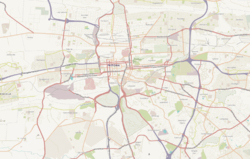Pretoria Forts
| Fort Schanskop | |
|---|---|
| Pretoria, South Africa | |

Fort Schanskop viewed from above
|
|

Fort Schanskop
|
|
| Coordinates | 25°46′39″S 28°11′06″E / 25.7775°S 28.185°E |
| Site information | |
| Controlled by |
|
| Open to the public |
Yes |
| Condition | Renovated |
| Site history | |
| Built | 1896 to 6 April 1897 |
| Built by | Friedrich Krupp AG |
| Events | Second Boer War |
| Garrison information | |
| Past commanders |
Lieutenant A. Carlblom |
| Garrison | Rijdende Artillerie, later Corps Vesting Artillerie |
| Occupants | 31 |
| Fort Wonderboompoort | |
|---|---|
| Pretoria, South Africa | |

Outer gate of Fort Wonderboompoort
|
|

Ruins of Fort Wonderboompoort
|
|
| Coordinates | 25°41′32″S 28°11′39″E / 25.6923°S 28.1942°E |
| Site information | |
| Controlled by |
|
| Open to the public |
Yes |
| Condition | Derelict |
| Site history | |
| Built | Completed 4 September 1897 |
| Built by | Friedrich Krupp AG |
| Events | Second Boer War |
| Garrison information | |
| Past commanders |
Lieutenant J. Wolmarans |
| Garrison | Rijdende Artillerie, later Corps Vesting Artillerie |
| Occupants | ±30 |
| Fort Klapperkop | |
|---|---|
| Pretoria, South Africa | |

Fort Klapperkop
|
|

SADF monument
|
|
| Coordinates | 25°46′49″S 28°12′36″E / 25.7802°S 28.2101°E |
| Site information | |
| Controlled by |
|
| Open to the public |
Yes |
| Condition | Renovated |
| Site history | |
| Built | 1896 to 18 January 1898 |
| Built by | Friedrich Krupp AG |
| Events | Second Boer War |
| Garrison information | |
| Past commanders |
Adjutant A.S.D. Erasmus |
| Garrison | Rijdende Artillerie, later Corps Vesting Artillerie |
| Occupants | 17–30 |
| Fort Daspoortrand | |
|---|---|
| Pretoria, South Africa | |

The main entrance of Fort Daspoortrand
|
|
| Coordinates | 25°43′59″S 28°04′36″E / 25.733038°S 28.076689°E |
| Site information | |
| Owner | Private |
| Controlled by |
|
| Open to the public |
No |
| Condition | Ruined |
| Site history | |
| Built | 1896 to November 1898 |
| Built by | Leon Grunberg and Sam Leon |
| Events | Second Boer War |
| Garrison information | |
| Past commanders |
|
| Garrison | Transvaal Staatsartillerie |
The Pretoria Forts consists of four forts built by the government of the South African Republic (ZAR) just before the outbreak of the Second Anglo-Boer War around their capital of Pretoria.
After the abortive Jameson Raid, the government of the ZAR became concerned about the safety of its capital city, Pretoria, both from foreign invasion as well as from the growing number of Uitlanders (Foreigners) on the Witwatersrand.Consequently, a defence plan for Pretoria was drawn up by a former French artillery officer, Leon Grunberg. This plan was approved on 24 March 1896 by the Executive Council of the ZAR.
The plan recommended that eight strategic positions around the city should be fortified by means of armoured turrets equipped with artillery. The positions identified were Schanskop, Kwaggaspoort, Daspoortrand, Magaliesberg-wes, Wonderboompoort, Derdepoort, Strubenkop and Klapperkop. The armoured turrets were subsequently found to be unacceptable, and thus the plan of two German engineers, Otto Albert Adolph von Dewitz and Heinrich C Werner to build forts instead, were accepted. However, due to a lack of money, only four forts were eventually built:
Fort Schanskop, Fort Wonderboompoort and Fort Klapperkop were designed by Von Dewitz and Werner of the German engineering company Krupp, assisted by architect Christiaan Kuntz and building contractor Celso Giri.
The three forts are pentagonal reinforced, with more fire range possibilities through numerous facets. Attacks from any direction could be warded off by revolving guns on their ramparts. To prevent infantry attacks, loopholes were built into the walls. Trenches, barbed-wire entanglements and fortified rooms were erected as reinforcements.
These forts were the most modern structures of their time and modern mediums of communication, such as telephones, were used to equip the telegraph room.
Many black labourers and about 400 white builders, mostly Italians, were involved in the building of these forts. To address technical aspects such as the electrical connections between forts, German and Dutch experts were consulted.
...
Wikipedia

